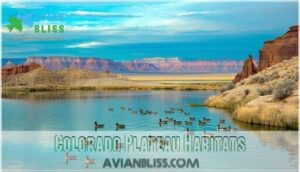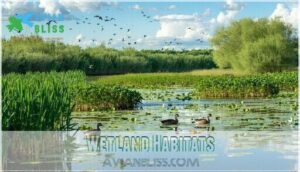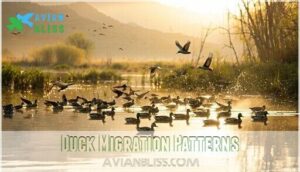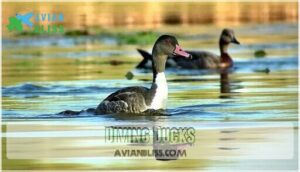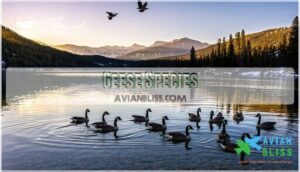This site is supported by our readers. We may earn a commission, at no cost to you, if you purchase through links.

These waterfowl navigate Colorado’s varied elevations, utilizing everything from high-altitude mountain lakes to prairie potholes. Common species include wood ducks nesting in cottonwood cavities, canvasbacks diving in deeper waters, and blue-winged teal skimming marsh surfaces.
Colorado’s position along the Central Flyway makes it a vital stopover for migrating waterfowl, with peak activity occurring during spring and fall migrations when thousands of ducks funnel through the region’s wetlands, creating spectacular viewing opportunities for those who know where to look.
Table Of Contents
- Key Takeaways
- Colorado Duck Species
- Duck Habitats Found
- Duck Migration Patterns
- Types of Colorado Ducks
- Conservation Efforts
- Frequently Asked Questions (FAQs)
- What kind of ducks are in Colorado?
- What is the rarest duck in Colorado?
- How rare are wood ducks?
- What ducks are native to Colorado?
- What is the big bird in Colorado?
- What is the limit on ducks in Colorado?
- What kind of bird has long legs in Colorado?
- What do ducks eat in Colorado?
- How do ducks communicate?
- What predators threaten ducks in Colorado?
- Conclusion
Key Takeaways
- You’ll find over 20 duck species across Colorado’s diverse habitats, from common mallards in urban parks to rare canvasbacks in high-altitude wetlands, with peak viewing during spring and fall migrations along the Central Flyway.
- Colorado’s four main habitat zones—Rocky Mountains, High Plains, Colorado Plateau, and wetlands—each support different duck species, with North Park serving as the state’s primary breeding ground due to flood irrigation creating ideal nesting conditions.
- You can identify four main duck categories: dabbling ducks that feed at the surface (like mallards and teal), diving ducks that plunge underwater (like canvasbacks and redheads), geese species, and other waterfowl like swans and coots.
- Conservation efforts focus on habitat preservation, water management through irrigation systems and flood control, and population monitoring, as duck populations face threats from habitat loss, water pollution, and climate change affecting over 50% of Colorado’s original wetlands.
Colorado Duck Species
Colorado’s diverse landscapes support over 15 duck species, from common mallards in urban ponds to rare canvasbacks in high-altitude wetlands.
You’ll find these waterfowl thriving across the state’s unique ecosystems, from Rocky Mountain beaver ponds to eastern plains reservoirs, which is a key aspect of the state’s diverse landscapes.
Native Duck Species
Among Colorado’s native duck species, you’ll discover remarkable waterfowl identification opportunities through diverse duck behavior and habitat preferences.
Mallards showcase distinctive mating habits with their iridescent green heads, while Northern Pintails demonstrate unique flock dynamics during migration.
These duck species excel in feather care, maintaining waterproof plumage essential for Colorado’s varied climates.
Nesting sites range from prairie potholes to mountain wetlands, supporting bird watching colorado enthusiasts year-round, with opportunities for observing unique flock dynamics.
Common Duck Species
You’ll spot these common Colorado ducks across the state’s diverse wetlands, where their distinctive feather types and beak shapes make waterfowl identification straightforward.
These species follow well-established migratory routes and have adapted their habitat needs to Colorado’s varied landscapes, making bird watching Colorado rewarding year-round.
- Mallards – Green-headed males with distinctive blue wing patches frequent urban ponds and agricultural areas
- Northern Pintails – Elegant ducks with pointed tails prefer shallow wetlands and flooded fields
- Blue-winged Teal – Small, fast-flying ducks with powder-blue wing coverts favor marshy environments
- Gadwall – Subtly patterned gray ducks with white wing patches thrive in deeper water habitats
Less Common Ducks
Colorado’s less common ducks present unique Duck Behavior challenges for wildlife enthusiasts.
Redheads, Ring-necked Ducks, and Canvasbacks showcase distinct Feather Patterns that distinguish them from typical water birds.
These migratory birds navigate complex Migratory Routes through Colorado’s duck habitat, adapting their Beak Shapes for specialized feeding.
Their Habitat Needs require deeper waters than dabbling ducks, making Colorado ducks’ duck migration patterns particularly fascinating for observing these elusive species during seasonal movements.
The ring necked duck exhibits notable diving behavior traits that aid in its foraging and survival.
Rare Duck Species
You’ll encounter elusive species that challenge even experienced birdwatchers, as these endangered ducks face mounting pressures from habitat loss and climate change.
Colorado’s most elusive ducks slip through wetlands like secrets, demanding patience from even seasoned watchers.
Their rare migrations depend on specific conditions, making conservation status monitoring critical for protecting Colorado’s most vulnerable waterfowl populations.
Here are five rare duck species occasionally found in Colorado:
- King Eider – Arctic vagrant with distinctive orange bill knob
- Harlequin Duck – Fast-water specialist requiring pristine mountain streams
- Long-tailed Duck – Deep-diving species from northern breeding grounds
- Black Scoter – Coastal duck rarely seen on Colorado’s inland waters
- Spectacled Eider – Critically threatened Alaska native with unique facial pattern
These river ducks and lake ducks represent fragile links in waterfowl genetics, requiring targeted duck conservation efforts to preserve their Colorado connections.
Duck Habitats Found
Colorado’s diverse landscapes create distinct duck habitats across four major ecological zones, each supporting different waterfowl species throughout the year.
You’ll find ducks thriving in everything from high-altitude mountain lakes to sprawling prairie wetlands, with each habitat offering unique resources that attract specific duck populations during breeding, migration, and wintering periods, particularly in high-altitude mountain lakes and other areas that support different waterfowl species.
Rocky Mountain Habitats
Mountain ecosystems across Colorado’s Rockies provide critical waterfowl habitat through alpine lakes, forest wetlands, and rocky shores.
You’ll find ducks thriving at high altitude locations where cold, clear waters support diverse aquatic life.
These forest habitats offer protected nesting sites, while Colorado wildlife benefits from established duck conservation programs targeting lake ducks and river ducks throughout duck hunting colorado seasons.
The use of effective decoy hunting tools is essential for successful waterfowl management and hunting practices.
High Plains Habitats
You’ll find the High Plains stretching across eastern Colorado, where shallow wetlands and seasonal ponds create perfect duck habitat.
The region’s Grassland Ecology supports diverse waterfowl through carefully managed Prairie Management practices.
- Water Tables remain closer to surface, sustaining pond birds year-round
- Soil Conservation programs maintain wetland integrity for duck diet diversity
- Ecosystem Balance supports both colorado wildlife and duck hunting colorado opportunities
- High Plains irrigation creates additional waterfowl habitat beyond natural systems
Colorado Plateau Habitats
Western duck habitat encompasses arid ecosystems where resilient waterfowl species adapt to desert landscapes and rocky terrain.
You’ll discover that Colorado Plateau ecology supports specialized pond birds through seasonal water sources at high altitudes, creating unique microhabitats within this challenging environment.
These hardy ducks have evolved remarkable strategies for surviving in conditions where traditional wetlands are scarce, making plateau habitats essential for Colorado wildlife diversity.
Wetland Habitats
Wetland habitats serve as Colorado’s duck headquarters, where shallow marshes and ponds create perfect nurseries for waterfowl families.
These aquatic ecosystems support diverse avian species through careful water quality management and habitat restoration efforts along the Arkansas River.
- Marsh ecology sustains duck sounds from mallards to pintails through abundant wetland plants
- Aquatic life provides essential protein sources, making these areas prime for bird photography enthusiasts
- Seasonal flooding creates temporary wetlands that boost duck facts and breeding success rates
Duck Migration Patterns
You’ll discover that Colorado’s ducks follow predictable seasonal routes, with most species using the Central Flyway as their primary migration corridor through the state.
These waterfowl time their movements around weather patterns and food availability, creating opportunities for birdwatchers to observe different species during spring and fall migrations.
Spring Migration
Starting in early March, you’ll witness Colorado’s spectacular spring duck migration unfold across the state’s diverse wetlands.
Migration Patterns show peak activity during March and April, when mallards, green-winged teal, and northern pintails arrive seeking Spring Habitat for nesting.
These avian species demonstrate fascinating Flocking Dynamics, with nocturnal movements concentrating in intermountain basins where abundant food fuels their Breeding Seasons preparation throughout Colorado.
The ducks’ migration is influenced by waterfowl conservation efforts in the region.
Fall Migration
Preparing for their southward journey, ducks begin gathering in Colorado’s wetlands during late August and September, utilizing established Migration Routes along the Central Flyway.
These Flyway Patterns guide flocks through the Rocky Mountains and South Platte River valleys, where Stopover Sites provide essential refueling opportunities.
Flocking Behavior intensifies as wildlife congregates at key locations, optimizing Habitat Use before continuing their migration toward warmer wintering grounds.
Understanding bird migration patterns is essential for conserving duck populations and their habitats, involving the study of complete concepts.
Wintering Grounds
Most ducks don’t tough out Colorado’s harsh winters, but some hardy species find refuge in the state’s unfrozen water sources.
You’ll spot mallards, common goldeneye, and bufflehead around Denver’s heated reservoirs and geothermal springs near Glenwood Springs.
Where water management keeps these winter habitats accessible despite frozen lakes throughout the Rocky Mountains.
Breeding Areas
Colorado’s breeding grounds center around North Park, where flood irrigation creates ideal nesting sites for waterfowl.
You’ll find these productive duck ponds and wetlands supported by careful water management from the Colorado River watershed.
Reservoirs and controlled drainage systems maintain essential water sources, making habitat preservation essential for sustaining these important breeding areas throughout the nesting season.
Types of Colorado Ducks
You’ll encounter four main categories of waterfowl when exploring Colorado’s diverse aquatic ecosystems, each adapted to specific feeding behaviors and habitat preferences.
These groups include dabbling ducks that feed at the water’s surface, diving ducks that plunge underwater for food, various geese species that graze on land and water, and other specialized waterfowl like swans and coots.
Dabbling Ducks
You’ll find dabbling ducks throughout Colorado’s shallow wetlands, where these surface feeders tip forward to grab aquatic plants and seeds from pond bottoms.
Over fourteen species call Colorado home, including widespread Mallards and seasonal Cinnamon Teal that frequent high-elevation marshes.
Their Duck Behavior centers on shallow water foraging, while Feather Care occurs during post-breeding molting periods when thousands gather at refuges like Monte Vista along key Migration Routes through Colorado’s diverse wildlife habitats.
The health of these ducks can be affected by molting cycle issues that impact their ability to regulate body temperature and maintain waterproof feathers.
Diving Ducks
Several diving duck species inhabit Colorado’s diverse aquatic environments, utilizing specialized feather structure and beak adaptation for underwater foraging.
These remarkable birds demonstrate unique diving techniques, plunging beneath the surface to access their preferred aquatic diet of mollusks, crustaceans, and aquatic vegetation.
Colorado’s natural resources and wildlife habitats support canvasback, redhead, and ring-necked ducks, whose duck behavior patterns make them fascinating subjects for outdoor adventures and scenic attractions throughout the state’s wetland ecosystems.
For enthusiasts, proper Diving Duck Gear is essential for successful underwater explorations, utilizing the right equipment to observe these diving duck species in their natural habitat.
Geese Species
While diving ducks prefer deeper waters, Canada geese represent Colorado’s most recognizable waterfowl species through their distinctive honking calls and impressive Geese Migration patterns.
You’ll witness remarkable Waterfowl Behavior as these large birds navigate Colorado’s natural resources, from mountain lakes to prairie wetlands.
Their complex Flock Dynamics showcase intricate Species Identification features, making Bird Conservation efforts essential for protecting these majestic creatures during outdoor adventures across Colorado’s scenic attractions.
Other Waterfowl
Beyond geese, you’ll encounter fascinating water birds throughout Colorado’s wetland ecosystem.
Swans grace mountain lakes with elegant necks, while coots paddle across rivers displaying unique avian behavior.
These species rely heavily on Colorado’s water resources for feather care and feeding.
During bird migration seasons, Colorado’s natural landscape supports diverse wildlife including grebes, pelicans, and cormorants across various lakes.
Conservation Efforts
You’ll discover that Colorado’s duck populations face significant challenges from habitat loss, water depletion, and climate change, making conservation efforts essential for their survival.
Colorado’s waterfowl face an uphill battle against shrinking habitats and climate pressures.
These thorough programs focus on habitat preservation, water management systems, population monitoring, and addressing the primary threats that impact waterfowl across the state’s diverse ecosystems, which is crucial for their survival.
Habitat Preservation
While Colorado’s diverse ecosystems provide critical wildlife habitat, you’ll find that wetland restoration projects and habitat conservation initiatives play essential roles in maintaining duck populations across the state’s varied landscapes.
Through ecosystem management practices and environmental sustainability efforts, wildlife protection programs focus on preserving Colorado’s natural ecology, ensuring that habitat conservation remains a priority for future generations of waterfowl and other species.
Effective duck habitat products, such as those found in Duck Habitat, are essential for conservation efforts.
Water Management
Building on habitat preservation efforts, you’ll find that water management forms the backbone of Colorado’s duck conservation strategy.
Irrigation systems, river management, and flood control work together to maintain the hydrological features that waterfowl depend on throughout their lifecycle.
- Irrigation Systems – Flood irrigation in areas like North Park creates shallow wetlands that provide critical breeding habitat for ducks during spring months.
- Water Quality – Agricultural runoff management and treatment facilities guarantee clean water reaches wetland areas, supporting healthy aquatic food webs.
- Flood Control – Controlled water releases from reservoirs mimic natural flooding patterns, creating seasonal wetlands without devastating downstream communities.
- River Management – Stream flow regulations maintain minimum water levels in the Arkansas and South Platte rivers during drought periods.
- Wetland Conservation – Precipitation capture and strategic water allocation preserve high-elevation basins that serve as essential stopover points during migration.
Effective bird conservation efforts are vital for maintaining these ecosystems.
Duck Population Monitoring
You’ll track Colorado’s duck populations through systematic surveys that reveal fascinating Population Trends and Migration Routes.
Scientists conduct aerial transects along river valleys each spring, counting breeding pairs to assess Habitat Quality and Breeding Success rates across different regions.
| Survey Method | Coverage Area | Annual Data Points |
|---|---|---|
| Aerial Transects | River valleys & reservoirs | 55,500 duck count (2024) |
| Ground Truth Counts | Major habitat zones | 1,000-2,000 banded ducks |
| GPS Telemetry | Migratory pathways | 5,000+ citizen observations |
| Drone Monitoring | Wetland perimeters | Real-time breeding data |
| Citizen Science | Statewide coverage | Atlas project contributions |
These Duck Counts help wildlife managers understand how Colorado’s environment affects breeding success and population stability.
Threats to Duck Habitats
You’ll find Colorado’s duck populations facing mounting pressures that threaten their survival across the Rocky Mountains and beyond.
Habitat Loss from urban development eliminates critical wetlands, while Water Pollution from agricultural runoff degrades remaining areas, and Climate Change disrupts traditional migration patterns throughout Colorado’s diverse ecosystems.
- Over 50% of Colorado’s essential wetlands have vanished forever since European settlement
- Duck brood survival plummets 35% during drought years when water sources disappear
- Agricultural pesticides poison wetland sediments where ducklings learn to forage
- Oil spills and urban runoff contaminate the pristine waters ducks depend on
- Invasive plants choke out native vegetation that provides essential nesting cover
Frequently Asked Questions (FAQs)
What kind of ducks are in Colorado?
Like birds of a feather, you’ll spot mallards, gadwall, blue-winged teal, cinnamon teal, northern pintail and green-winged teal swimming across wetlands, with Common Goldeneyes and Hooded Mergansers diving for fish.
These waterfowl species can be identified using duck species guides.
What is the rarest duck in Colorado?
You’ll spot black-bellied whistling-ducks among Colorado’s rarest waterfowl species, though they’re increasingly expanding their range northward from traditional southern habitats.
How rare are wood ducks?
You’d encounter wood ducks fairly easily in suitable wetlands since Partners in Flight estimates the global breeding population at 6 million.
This indicates a species of low conservation concern, as they rate them 7 out of 20 on the Continental Concern Score.
What ducks are native to Colorado?
Like a feathered symphony floating across mountain skies, you’ll discover mallards, gadwall, green-winged teal, cinnamon teal, and northern pintail gracing Colorado’s wetlands as common native species.
What is the big bird in Colorado?
You’ll spot Colorado’s largest bird overhead – the American White Pelican, measuring 62 inches long with a nine-foot wingspan. These massive, impressive birds soar majestically across Colorado’s skies.
What is the limit on ducks in Colorado?
Based on the current Colorado duck hunting regulations, you’re allowed a daily bag limit of 6 to 7 ducks depending on your hunting zone.
With specific restrictions by species and location zones across the state, daily bag limit is an important consideration for hunters to be aware of.
What kind of bird has long legs in Colorado?
Standing tall like feathered soldiers patrolling wetlands, you’ll spot great blue herons and great egrets wading through Colorado’s marshes, their spindly legs perfectly designed for hunting fish.
What do ducks eat in Colorado?
You’ll find ducks in Colorado munching on aquatic plants, seeds, insects, crustaceans, small fish, and invertebrates. They’re adaptable eaters who also feast on agricultural crops, berries, buds, and acorns seasonally.
How do ducks communicate?
Ducks communicate through various vocalizations like quacks, whistles, and grunts, each conveying different messages.
They’ll also use body language, head movements, and wing displays to express emotions, establish territories, and coordinate with their flock effectively, utilizing complete concepts to do so.
What predators threaten ducks in Colorado?
Over 80% of duck nests fail due to predation. You’ll find coyotes, raccoons, skunks, and birds of prey threatening Colorado’s ducks, targeting eggs, ducklings, and adults throughout their lifecycle.
Conclusion
Consider the birdwatcher who documented 12 different Colorado ducks species during a single October weekend at Chatfield State Park—this exemplifies the remarkable diversity awaiting observers across the state.
Colorado ducks represent one of North America’s most dynamic waterfowl communities, with species utilizing diverse habitats from mountain lakes to prairie wetlands.
Your exploration of these birds reveals intricate migration patterns, specialized feeding behaviors, and critical conservation needs.
Understanding Colorado’s duck populations enhances appreciation for wetland ecosystems while supporting informed stewardship decisions that guarantee future generations can witness these spectacular avian displays throughout the state’s waterways.
- https://birdcast.info/science-to-action/lights-out/peak-migration-dates-for-u-s-cities/
- https://efotg.sc.egov.usda.gov/references/public/CO/Tech_Note_41_Biology.pdf
- https://www.divebombindustries.com/blogs/news/duck-hunting-in-the-rocky-mountains-high-altitude-hunts
- https://iwjv.org/of-ducks-and-ditches-infrastructure-and-habitat-in-colorados-north-park/
- https://www.riversedgewest.org/about/news/dabbling-ducks-supporting-waterfowl-habitat-through-collaboration-private-lands




